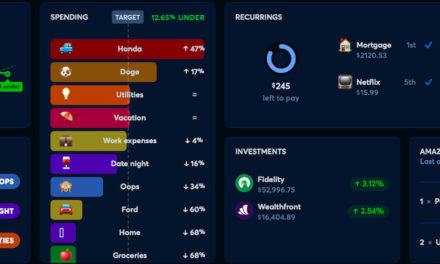Budgeting can be a real game-changer when it comes to managing your family’s finances. But when you make a family budget, make sure it includes common hidden expenses.
Even the most meticulous budgeters can overlook certain expenses.
These expenses seem simple enough individually, but when added up they can create some serious havoc on your monthly planning if you don’t include them.
They tend to lurk beneath the surface of household budgets.
Often overlooked, these hidden costs can catch families off guard, causing financial stress and, in some cases, creating the possibility of making hasty financial decisions.
By including these common overlooked expenses when you make a family budget, you’ll be better equipped to maintain control over your family’s financial health, avoid sudden financial surprises, and stay on course towards your financial goals.
How to pick a financial planner that works for your family
Here are 7 Commonly Forgotten Expenses When You Make a Family Budget
1. Seasonal Expenses
The Problem
Seasonal expenses can be a significant budgeting hurdle. These include items like holiday gifts, holiday decor, summer camps, back-to-school supplies, winter heating costs, or even occasional car maintenance related to weather changes. These costs are easily forgotten in the midst of day-to-day budgeting, because they tend to lurk just one time a year but they can quickly strain your finances when they arise.
The Solution
To address seasonal expenses, create a dedicated “Seasonal Expenses” category within your budget. Begin by identifying and estimating the costs of these events and items over the year. Then, divide the total by 12 and set aside that amount each month. This way, when these expenses pop up, you’ll have the necessary funds without causing financial stress. Also, plotting them out on a calendar or budget tracker can do wonders for planning for upcoming expenses.

2. Educational Expenses
The Problem
For families with children, education-related costs are a significant part of the budget. These include school supplies, extracurricular activities, and even tutoring services. These expenses are often underestimated or forgotten in the budgeting process.
The Solution
To account for educational expenses, create an “Education” category in your budget. While you may not have items included in this line item every month, insert estimated costs associated with your children’s education, including those listed above. By planning for these expenses in advance, you can ensure your children have access to educational opportunities without straining your finances.
3. Birthday and Celebratory Expenses
The Problem
If you’re anything like us, with two elementary-age boys, it feels like we’ve got a birthday party (or more) nearly every weekend. Buying presents for all these events can really add up. That doesn’t even count planning and enjoying birthdays from your own family. From gifts and parties to travel and dining out, these costs can strain your budget if you don’t take a look at the whole year and know when these costs might swell.
The Solution
To manage celebratory expenses, set spending limits and consider creative, budget-friendly ways to celebrate, such as DIY gifts and home-cooked dinners, where possible. If you’ve got kids, there’s no rule that says you must accept every birthday party invite, especially the ones where the whole class is invited. We’ve set a limit for how much we spend on birthday gifts for our kids friends and moved from buying just another toy to a gift card, which (we believe) is a bit more practical and a consistent budgeted cost. Though, I admit, is less exciting to open.
4. Subscriptions and Memberships

The Problem
In the era of streaming services, gym memberships, and various subscription boxes, it’s easy to accumulate monthly expenses without realizing it. These costs can pile up quickly, leading to overspending without you even realizing it. It’s become so bad, there’s even commercials promoting apps that will cancel these subscriptions for you.
The Solution
Take a close look at your budget and evaluate all subscriptions and memberships. Cancel those you don’t use or need regularly. For the ones you wish to keep, include each one in your budget as separate line items. This way it is clear what services you’re using and nothing is “hidden” from view. To save even more, consider bundling services when possible, and always be mindful of new subscriptions you might be tempted to add with “free limited time offers” but result in full charges if you don’t cancel in time.
5. Medical Expenses
The Problem
Healthcare is an ever-present expense, but it’s often underestimated. People tend to remember the major medical bills and insurance premiums but forget about co-pays, prescription costs, and unexpected medical bills. For families, especially those with children, flu season expenses can add up quickly with trips to the drug store for cough and cold medicine and other products.
The Solution
If possible, first take advantage of a Flexible Spending Account or Health Savings Account from your insurance, to gain access to tax-free spending money. Next, a “Medical” category within your budget and set money aside each month, even if you don’t spend it. Estimate your annual medical expenses, including regular check-ups, prescriptions, and potential emergencies. Divide this annual amount by 12 to determine how much you should save monthly. This can become your own personal savings stash that is committed to medical/health expenses and won’t break the bank.
6. Home Maintenance and Repairs
The Problem
Homes require ongoing maintenance, and occasional repairs are inevitable. It’s easy to overlook these costs until a pipe leaks, the roof needs repair, or a major appliance breaks down. Neglecting home maintenance can lead to hefty expenses when things finally go awry.
The Solution
To address home maintenance and repair expenses, build out a calendar so you can more accurately predict when certain expenses may occur. Do you need gutter cleaning twice a year? Does your roof need to be de-mossed? Does you fireplace need to be cleaned? You typically know what time of year these type of services are needed so set aside a percentage of your income, typically 1-3%, to cover these expenses. This ensures you’re prepared for both routine maintenance and unexpected repairs, ultimately saving you money in the long run by avoiding larger, preventable issues.
7. Vehicle Maintenance and Repairs
The Problem
Cars require regular maintenance, such as oil changes and tire replacements. Beyond these routine costs, major vehicle repairs can be a financial shock. Failing to budget for vehicle expenses can lead to added stress when your car breaks down.
The Solution
To manage vehicle-related expenses, establish a “Vehicle” category in your budget. Allocate a portion of your income for regular vehicle maintenance, including oil changes, tire rotations, and other routine upkeep. Additionally, create an “Emergency Vehicle Repair Fund” to handle unexpected car repairs. This way, you’re always financially prepared to deal with vehicle-related costs.
My favorite budgeting app will do all the work for you
Make A Family Budget that Goes Beyond the Basics

Budgeting is about more than just covering your everyday expenses.
To truly take control of your family’s finances, it’s essential to account for all potential costs. By remembering these commonly forgotten expenses when you make a family budget, you can enjoy peace of mind, reduce financial stress, and stay on track to meet your financial goals.
I built a spreadsheet that looks all the way through the end of 2024 with recurring expenses and anticipated income to get a much larger glimpse of our financial picture.
Remember, budgeting is an ongoing process.
As your family’s needs and circumstances change, your budget should adapt accordingly. Regularly review your budget to ensure it accurately reflects your financial situation.
I look at ours multiple times a month as expenses and income become more clear.
With a well-structured budget that considers all potential expenses, you’ll be better prepared to handle life’s curveballs and maintain financial stability. Don’t let these commonly forgotten expenses derail your financial plans—start the process and make a family budget today.
I am not a financial professional. The information in this post is for informational purposes only. I may receive compensation from advertisements when you click on links to those products on this page.













